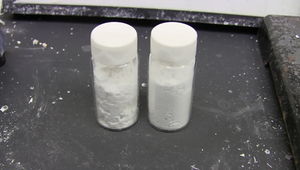Sodium cyanide
 Impure sodium cyanide made by NurdRage
| |
| Names | |
|---|---|
| IUPAC name
Sodium cyanide
| |
| Other names
Cyanide of sodium
| |
| Properties | |
| NaCN | |
| Molar mass | 49.0072 g/mol |
| Appearance | White solid |
| Odor | Faint almond-like |
| Density | 1.5955 g/cm3 |
| Melting point | 563.7 °C (1,046.7 °F; 836.9 K) |
| Boiling point | 1,496 °C (2,725 °F; 1,769 K) |
| 48.15 g/100 ml (10 °C) 63.7 g/100 ml (25 °C) | |
| Solubility | Soluble in ammonia, ethanol, methanol Slightly soluble in dimethylformamide, liq. SO2 Insoluble in DMSO |
| Thermochemistry | |
| Std molar
entropy (S |
115.7 J·mol-1·K-1 |
| Std enthalpy of
formation (ΔfH |
-91 kJ/mol |
| Hazards | |
| Safety data sheet | Sigma-Aldrich |
| Flash point | Non-flammable |
| Lethal dose or concentration (LD, LC): | |
| LD50 (Median dose)
|
6.44 mg/kg (rat, oral) 4 mg/kg (sheep, oral) 15 mg/kg (mammal, oral) 8 mg/kg (rat, oral) |
| Related compounds | |
| Related compounds
|
Potassium cyanide |
| Except where otherwise noted, data are given for materials in their standard state (at 25 °C [77 °F], 100 kPa). | |
| Infobox references | |
Sodium cyanide is an inorganic compound with the formula NaCN.
Contents
Properties
Chemical
Sodium cyanide reacts with halocarbons to give nitriles. Iodine can be used as catalyst.
Physical
Sodium cyanide is a white crystalline solid, soluble in water.
Availability
Sodium cyanide is sold by chemical suppliers, but due to it's toxicity, companies won't sell to the amateur chemist.
Preparation
Preparation of sodium cyanide is extremely dangerous and an inexperienced chemist may even die if proper safety protocols aren't in place. Do not attempt to synthesize NaCN if you don't know what to do. No seriously, don't.
A common route involves the reaction of molten sodium hydroxide with cyanuric acid. To do this, in a molten alkali crucible/can add 100 g of sodium hydroxide, 43 g of cyanuric acid and 12 g of carbon, which can be ordinary charcoal, though activated carbon may work better, due to its high surface area. Using a metal rod, mix the components. Slowly heat the mixture for 1 hour until it melts and raise it to 600 °C. The reaction produces trisodium cyanurate and water, which boils off. Above 550 °C, trisodium cyanurate breaks down to sodium cyanate, which is further reduced by carbon to sodium cyanide. Carbon dioxide is formed, which boils off, producing lots of bubbles. Lots of sodium carbonate will be produced, as some of the carbon dioxide does not escape and instead it reacts with the molten sodium hydroxide. When the bubbling stops, turn off the heating and let it cool. Break apart the resulting solid and add methanol to dissolve sodium cyanide, as sodium carbonate and carbon are insoluble in methanol. After most has dissolved, add 100 g of sodium bicarbonate to neutralize the leftover sodium hydroxide, since NaOH is soluble in methanol, but sodium carbonate is insoluble. Filter the solution and remove the methanol to get solid sodium cyanide. The final product is impure, but can be further purified via recrystallization.[1]
Another route involves melting a mixture of sodium hydroxide with urea. Sodium cyanate is used, which is ground, mixed with a reducing agent like carbon, magnesium and ignited in a thermite-like reaction. This produces sodium cyanide and magnesium/carbon oxide. Dissolve the mixture in water and filter it to get rid of the magnesium oxide/hydroxide. This process gives crude sodium cyanide which needs to be purified.
Projects
- Dissolve gold
- Make nitriles
- Make cyanogen and cyanuric chloride
Handling
Safety
Sodium cyanide is highly toxic. Doses as small as 200 mg can kill a fully grown man.
Storage
Sodium cyanide should be stored in closed bottles, away from any acids, in a locked cabinet with a clear hazard label on the storage bottle.
Disposal
Sodium cyanide can be destroyed by oxidizing it with excess bleach or hydrogen peroxide to the less harmful sodium cyanate.